When the original Gears of War first graced the Xbox 360, all the way back in 2006, it was all about tactical warfare. Punishing enemies, an emphasis on taking cover and smartly navigating the battlefield, and dependence on co-ordination with teammates, especially on higher difficulties, all led to Gears of War seamlessly marrying the idea of tactical shooter mechanics with an apocalyptic sci-fi backdrop, a backdrop that’s normally reserved for white-knuckle action games. Subsequent entries in the series would ultimately move further away from this strategic flavouring, prioritizing the more fast-paced action that you would expect the franchise to bring at first glance, but there’s no denying that the Gears franchise was initially built on a foundation of strategy.
Finally, for those longing for the days when Gears made you think, you can go all in on that tactical foundation as well!… If you’re a PC gamer, that is. Gears Tactics marks the Gears series’ first-ever triple-A spin-off in the dedicated video game space (mobile game offshoot, Gears Pop! excluded), following in the footsteps of its cousin series, Halo in making a strategy-themed side offering to a shooter franchise that’s normally all about quick reflexes and intense firefights. The difference with Gears Tactics however is that it’s designed from the ground up to specifically take advantage of the technical capabilities behind Windows 10 PC’s, contrary to the console-oriented Halo Wars games. An Xbox One version of Gears Tactics is in development, mind you, but it’s currently without any kind of scheduled release window.
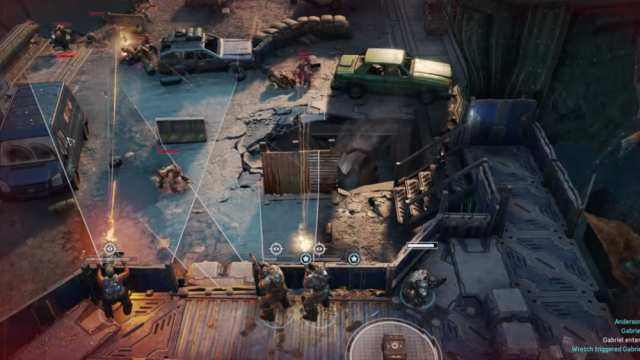
Moving the Gears series to a turn-based strategy format might initially feel as far from the franchise’s core gameplay appeal as you can imagine. You would be surprised at how well it works though! Gears Tactics delivers a well-thought-out, surprisingly enjoyable TBS experience, differentiating itself from Halo Wars with its more methodical turn-based gameplay. As it turns out, the one squad-against-legions format of the Gears games fits the TBS genre like a glove, allowing players to customize a squad of one to four units, and pit them against overwhelming odds, as they struggle to accomplish certain objectives against the monstrous Locust Horde.
Gears Tactics isn’t the kind of game that will revolutionize the TBS genre, especially when it’s rather transparently taking inspiration from the punishing, but fair foundation of fan-favourite TBS franchise, XCOM. As a refined, enjoyable and highly customizable experience however, Gears Tactics presents a lengthy, polished and highly rewarding series of missions that will effectively test your strategic acumen. The gameplay variation can get a little repetitive in some spots, and the complete lack of multiplayer will also disappoint some strategy gamers, but Gears Tactics nonetheless presents what could be Microsoft’s best sleeper hit this year, even with the Xbox Series X looming on the horizon.
For a turn-based strategy game especially, Gears Tactics boasts some truly amazing production values, though you’ll need a very powerful PC to properly take advantage of its many advanced graphical features. As with any first-party Xbox Game Studios title as well, Gears Tactics also demands Windows 10 to run in the first place. So long as you do have a Windows 10 PC with DirectX 12 capability however, Gears Tactics boasts an incredibly flexible set of graphical options, along with some surprisingly relaxed minimum system requirements. No matter what kind of PC you have, as long as Microsoft’s core OS demand is satisfied, your computer can no doubt run Gears Tactics on at least modest settings, where it remains a well-produced, visually pleasing experience.

Like I said however, it’s on beefy, high-powered PC’s that Gears Tactics shines the most. The Coalition has put together some truly spectacular flexibility and benchmark tools with the PC ports of Gears of War 4 and Gears 5 especially, but somehow, they and Gears Tactics developer, Splash Damage have raised the bar even further for PC gamers here. Not only is Gears Tactics’ benchmark tool even more advanced than the one in Gears 5’s PC version, sporting its own frame graph, and variable A.I. that mixes up character animations and effects to keep PC technical tests interesting, but Gears Tactics also happens to boast an even further refinement of the Unreal Engine 4 than what Gears 5 featured! This allows Gears Tactics to begin experimenting with visual features like variable rate shading, which reduces shadow detail that’s normally undetectable to the human eye in order to boost play performance, and is one of many new graphical features that are being extensively touted for Microsoft’s upcoming next-gen console, the Xbox Series X.
Aside from the nitty-gritty of Gears Tactics’ shadows, reflections and texture details (all of which are outstanding!), higher-end PC’s also have an easy ability to customize just about any discernible video option between settings ranging from, “Low” to, “Insane”, and that includes being able to push the resolution and framerate to some truly impressive levels. Even cutscenes can have their performance upgraded to the 60fps mark quite easily on higher-end PC’s, and gameplay performance can be pushed as high as 120fps with a strong enough graphics processor! Even mid-range PC’s can maintain a slick 60fps minimum framerate without breaking much of a sweat, in fact, making Gears Tactics excellently optimized for the PC platform. Naturally, Gears Tactics boasts some truly stunning 4K resolution options as well, with the 60fps minimum performance even holding up pretty well with 4K resolution enabled on high-end PC’s, and play performance usually only being disturbed if shadows and reflections are set too high, and over-taxing your GPU.

The only slight knock against Gears Tactics’ otherwise fantastic (and robust!) visual suite is that a few inherent graphical hiccups can sometimes occur here and there, even on more modest, undemanding settings. At worst, I did also experience some crashes, wherein I was booted back to my desktop after a gameplay script didn’t load quite right. Thankfully, these crashes are very rare in the final release build though, and I only encountered about two or three of them across an entire thirty-hour playthrough of the campaign. Gears Tactics’ stability may not quite be perfect, but it nonetheless bears repeating that even lower-end Windows 10 PC’s can get the game to run without much hassle, especially since the gameplay pace is ultimately pretty laid-back, as with any turn-based strategy game. If you do have the kind of powerful PC that can really push the settings of Gears Tactics however, the game is a true technical marvel, especially for its genre, providing a tantalizing look at some of the graphical technology that we can eventually expect to be part-and-parcel with the upcoming Xbox Series X.
Even with the change in genre, Gears Tactics’ audio suite remains fairly impressive. Despite the birds-eye view, it’s still easy for the especially pronounced sound effects and voice acting to pull you into the battles you’re waging, if not to quite the same degree as the Gears series’ mainline shooter offerings. There do seem to be a few recycled voice clips and audio effects here and there, particularly on the Locust end, but Gears Tactics’ audio nonetheless remains gripping and action-packed, particularly if you happen to have high-end computer speakers or headphones to fully take advantage of the immersive warfare.
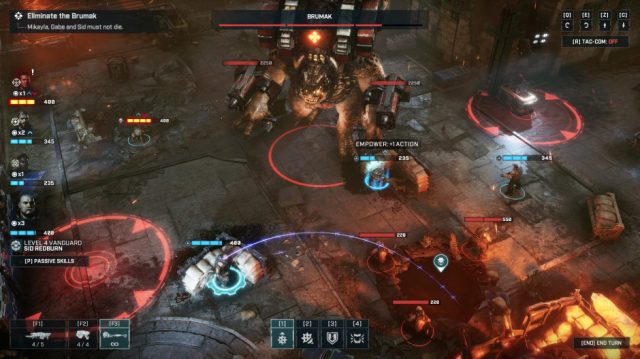
The orchestral music suite is pretty par for the course as far as Gears games go, and more often than not, the music will often be drowned out by the sound effects of the actual battles. It’s certainly true that Gears Tactics certainly sounds like a Gears game, for better or for worse, and while its audio doesn’t feel quite as novel or intense as the audio suites contained within the series’ main shooter entries, you do at least feel like you’re playing an authentic Gears experience throughout. This isn’t a game that really pushes the audio capabilities of a Gears title, but it definitely captures the feel of the audio that has come to define the franchise, even if you’re not in the thick of the action this time.
Gears Tactics will be instantly familiar to anyone who has played XCOM, or even any number of strategy-RPG’s. Indeed, it’s pretty accurate to not just describe Gears Tactics as a turn-based strategy game, but also a strategy-RPG in its own right. After all, favoured units will level up and be able to acquire new skills as they complete missions, with players also able to sub out their weapons, armour and other such modifiers, and finally, every unit in the game, both ‘heroes’ that must be kept alive, along with COG grunts that they recruit along the way, comes with a certain ‘class’ that dictates their potential skills and aptitude.
The addition of RPG elements might initially seem a little daunting to Gears fans that consider themselves all about the action, but fortunately, Gears Tactics strikes a good balance between giving players the flexibility to build the COG squadrons that they want to build, while also presenting simple, user-friendly mechanics that make it very simple to figure out how best to outfit your units. Units will probably only gain a few levels even as you approach the end of the game, but every level gained awards players two valuable Skill Points. These Skill Points can be used to unlock new Passive Skills (which are always in effect when the unit is used on missions), and Active Skills (which the player must manually activate, and can’t use again until a certain amount of turns pass), with each class having four branching Skill Tree paths that allow players to further refine a unit’s capabilities to their desired play style. Certain key missions will award you a limited amount of ‘Reset Tokens’ as well, which can be spent to reset a unit’s Skill Points, if you suddenly decide you want to re-tool that unit with a different set of abilities.
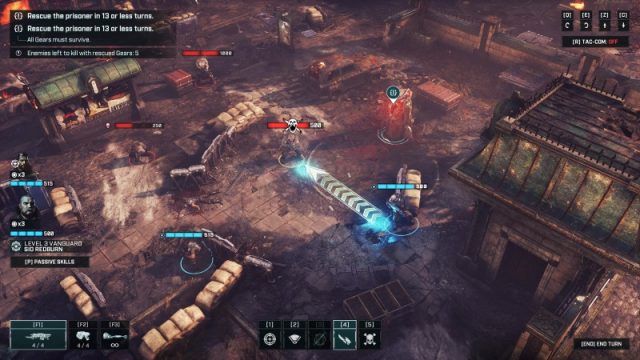
While you can’t change a character’s core class in Gears Tactics, and you are locked into using or not using certain ‘hero’ units, or limited amounts of units, in certain missions, players are given lots of freedom in terms of approaching missions the way they’d prefer to do so. This also allows uninitiated strategy gamers to quickly wrap their heads around ideal unit development without a ton of unit micromanagement, even if this means that main weapons are locked to their respective classes and heroes. For example, lead character, Gabe is a Support unit, and as such, he can only wield the series’ standard-issue chainsaw-equipped assault rifle, the Lancer. Likewise, Scout units can only utilize Gnasher shotguns, Heavies must make use of Mulcher gatling guns, Vanguards are stuck with the bayonet-brandishing ‘Retro Lancers’, and Snipers, naturally, make use of the Longshot sniper rifle. It is possible to find more heavy-duty weapons such as the grenade launcher-esque Boomshot, and the explosive Torque Bow, but they can only be plucked from certain enemy units, and they only have a few shots to make use of before they’re spent.
Managing your units is crucial in terms of leveraging their weapons, and how both your units and the enemy units can trade damage with each other. Scouts, for example, are powerful units that can do a lot of damage, but they’re also dependent on being dangerously close to enemy units. Likewise, units wielding Lancers and Retro Lancers can provide balanced damage from a distance, and can also insta-kill enemy units with an execution, without needing to ‘down’ them first, but they can only do so if they’re properly lined up with an enemy unit. Players have anywhere from one to four units to use in each mission, and in many cases, a balanced party is ideal. Players that really want to challenge themselves can try to arrange a party or skill set according to an optional objective within each mission though, which can include never using grenades, or forcing yourself to add a certain unit class to your team, among other examples, with the reward being an additional piece of equipment, if they’re achieved.

Enemy units, meanwhile, can take advantage of a bit more variation than your COG heroes. Much of the time, you’ll simply be up against Drones, which often wield assault rifles, not unlike your Lancer units. In other cases however, you’ll need to take on other Locust types, including Wretches, which swarm and melee attack your units in numbers, Grenadiers, which devastate your units with localized damage, Boomers, which have tons of health and wield explosive Boomshots, and Theron Guards, which wield Torque Bows, and can redirect other Locust to focus their attacks on certain units, among many other examples. As with any TBS game, both your faction and the enemy faction take turns moving their units, attacking and accomplishing other important functions within their respective ‘phases’, or turns, with units usually being able to execute up to three ‘actions’ per turn in this case (though they can gain additional actions with certain skills), and also being able to spend one to three actions on moving around the battlefield, depending on how far they move.
Directly picking off enemy units during your turn isn’t the only way to keep your squad fortified and healthy however! Gears Tactics also employs a great mechanic called ‘Overwatch’, which allows units with unused actions to point their weapons in a certain direction on the battlefield. Should enemy units come into the ‘Overwatch’ cone of sight, that unit will fire on the enemy, either doing some damage to them, or even potentially interrupting them, and preventing them from completing the action they had planned! The trade-off, of course, is that the enemy Locust units can also utilize Overwatch, leaving your units sometimes having to risk being damaged or interrupted themselves, as you try to move them into position for your next wave of attacks. Managing Overwatch can be a brilliant risk/reward system on both sides of the battlefield, just as knowing when to use Active Skills can potentially turn the tide after an otherwise damaging enemy assault. This is especially crucial when any ‘hero’ unit being killed (not incapacitated, but fully killed), results in an instant Game Over, and other COG units sustain permadeath. Thus, if these non-story-sensitive units are offed by the Locust, they’re gone forever.
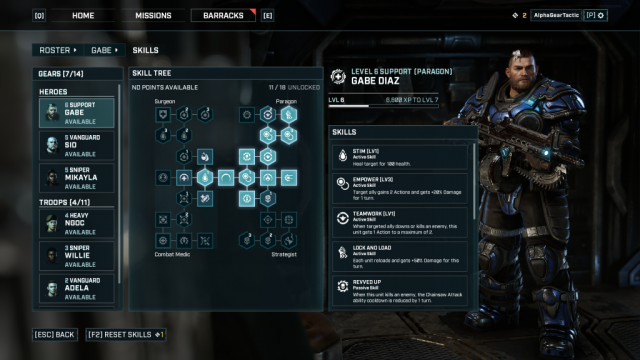
While tactical errors can often be severely punishing in Gears Tactics, with units often quickly losing health from enemy fire on higher difficulties especially, the game’s command inputs are at least very easy to manage, whether you’re playing with a keyboard and mouse, or an Xbox controller. Some of the Xbox controller inputs can be a little odd, such as being forced to use the D-Pad to rotate the battlefield, or having to navigate command menus by manually selecting your desired input with the Y Button and left thumbstick, every time, but playing with a controller does at least help to alleviate some of the occasionally finicky mouse inputs. Meanwhile, keyboard navigation is great, with Gears Tactics’ many skill-oriented keyboard shortcuts often feeling like the ideal input method, though as I said, the game’s mouse inputs can sometimes be a little unreliable, occasionally moving a unit when you meant to attack, etc.. This is made worse by the fact that you can’t even undo a simple movement command in Gears Tactics, something that feels rather unforgiving (in the developers’ defense, this approach is probably meant to sustain the integrity of Overwatch), but at least simply being very careful with your clicks can help to avoid this issue.
There may be a small learning curve for players who haven’t already spent a lot of time with the TBS genre, but once you get used to Gears Tactics’ play mechanics, it’s incredibly easy to approach, albeit nicely difficult to master. This is especially apparent during the game’s handful of boss missions, which pit you against a lengthy, challenging battle against a larger Locust strain, such as a Corpser or a Brumak. The boss missions often represent Gears Tactics at its most exciting and creative, which is why it’s a shame that there’s ultimately very little of them. These boss missions best make use of the blend between familiar TBS gameplay and Gears-specific conventions, such as taking cover behind obstructions to reduce or avoid enemy fire, or tossing grenades into opening Emergence Holes, which keep spewing enemy reinforcements for several turns, until they’re plugged by an explosive.

Outside of these especially exciting story missions however, Gears Tactics’ surprisingly robust campaign can sometimes feel a little more repetitious than it should. The game’s mission variety is really wanting during these dry spots in the story, with efforts to artificially prolong the game being especially apparent when you’re forced into ‘side missions’. The first time you play each of these side mission varieties, they’re a lot of fun, tasking you with getting your units to do things like sabotage enemy reactors, hold two supply points, or keep fleeing from a pursuing hail of Nemacyst bombings each turn. Later in the game however, the same handful of mission types keep popping up, and it’s easy for some of these missions to feel like mindless busy work, especially if you’re a skilled strategy gamer with a strong team of units, who will more easily repel the Locust forces during most of the later missions.
Fortunately, you do certainly get your money’s worth with Gears Tactics, since you’ll spend at least thirty hours before making it to the end credits. At this point, you’ll also be able to participate in the Veteran Missions, allowing you to remix the familiar mission types from the campaign to keep leveling up your units, and accruing more rewards. This feature is best enjoyed by achievement hunters and die-hard completionists, but it is a decent way to keep stretching your strategy skills, taking on increasingly devious platoons of Locust, as you try to score ever more valuable cases of new equipment for your units.
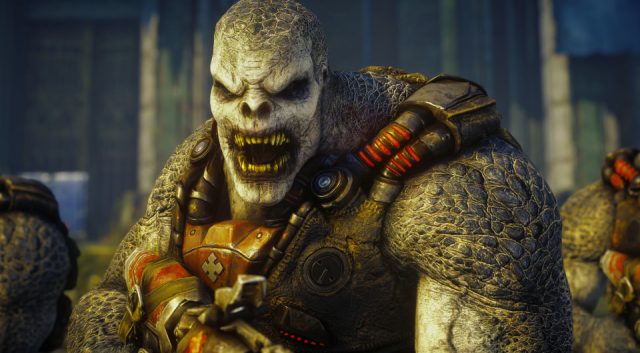
As fun and well-designed as Gears Tactics is though, and as much as it’s appreciated that it doesn’t contain any microtransactions, nor any apparent future DLC plans (though there is pre-order DLC, namely a ‘Thrashball Cole’ hero unit), the complete lack of multiplayer modes might make this game a tough sell for more competitive or socially-minded strategy gamers, especially after the Halo Wars games both featured multiplayer. Gears Tactics doesn’t feel like it needs a multiplayer mode per se, but the fact that it’s single-player-only can sometimes exacerbate the problem that the post-game Veteran Missions, like any other mission variety in Gears Tactics, will eventually feel dull and unrewarding in excess.
Fortunately, Gears Tactics’ thrilling, challenging and rewarding suite of gameplay does manage to invite repeat playthroughs for those who want to attempt the game on higher difficulties, or keep maxing out their units’ capabilities. Especially sadistic tacticians can even attempt the ‘Ironman Mode’, a Gears franchise tradition, which forces a player to restart the entire game if just one of their hero units is killed! For Gears fans that are uninitiated in strategy gaming, the beginning portion of Gears Tactics will be a bit daunting at first, even on lower difficulties, but eventually, you’ll settle into a groove, and likely find yourself loving the surprisingly seamless blend between turn-based battle planning, and explosive Gears action!
If you want a break from the Swarm that serve as the core threat of The Coalition’s newer Gears games, Gears Tactics happily goes back to the early days of the war against this franchise’s OG enemy faction, the Locust Horde. Taking place one year after Emergence Day, wherein the Locust first appeared and declared war on the human population of the planet, Sera, Gears Tactics provides a new angle on the early days of the Locust War, largely seen from the perspective of Sergeant Gabriel “Gabe” Diaz. Gabe happens to be the father of The Coalition’s female Gears lead, Kait Diaz as well, providing an interesting connection between these earlier days of the Locust War, and the newer conflicts that are currently raging in The Coalition’s post-Locust Gears entries.
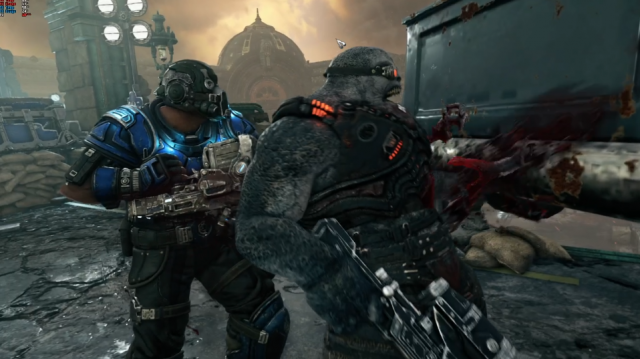
Unfortunately, that interesting concept is ultimately only taken so far. For all of its efforts to flesh out another important era of the Locust War, Gears Tactics sports a disappointingly shallow storyline, one that fails to tell avid Gears fans much of anything that they don’t already know, or haven’t already put together, especially if they’ve indulged in extended universe Gears media, like the Gears novels and comic books. For what it’s worth however, fans of the Gears comics will also recognize Gears Tactics’ menacing lead villain, Ukkon, an intelligent Locust Sire that also happens to be responsible for the creation of large Locust monsters, such as the previously mentioned Corpser and Brumak. This provides an intriguing look at how some of the bigger beasties of the Gears universe came to be, and how Gabe and his squad attempt to rally together and find a way to destroy Ukkon, before the Locust can come up with any more gargantuan monsters with which to decimate humanity.
This is a very cool premise, and indeed, there are some standout character moments during a few of Gears Tactics’ best cutscenes. That being said, the characters in this game only get so much development, with Gears Tactics’ over-arching battle against Ukkon ultimately boiling down to a simple series of investigations and operations by Gabe’s squad. This is quite disappointing, since fans will likely need to dig into ancillary Gears media for better fleshing out of this game’s events, with only a few noteworthy highlight scenes in Gears Tactics providing any meaningful added insight into this prequel era for the Gears universe. Perhaps this is due to The Coalition wanting to withhold bigger story developments for potential sequels in this spin-off series, but either way, if you’re coming to Gears Tactics hoping for a good story, you’re going to be disappointed. As with many Gears games before it, Gears Tactics is more about cutting down Locust than it is noteworthy world-building.
Gears Tactics feels more forward-thinking for the Gears franchise than it does for the turn-based strategy genre, where it’s more of a refinement of established mechanics than it is a true revolution for TBS gameplay. Still, Gears Tactics is also a polished, engaging and rewarding experience, one that makes for a surprisingly standout Gears spin-off. Fans of strategy games will love the flexible, yet user-friendly gameplay that emphasizes clever tactics as much as it does able firepower. Likewise, Gears fans will find a refreshingly faithful, yet sharply clever new spin on the series they love. Between the two, Gears Tactics skews a little more towards appealing to Gears fans over especially hardened strategy gamers that are looking for the next big thing in the genre, but even if Gears Tactics isn’t quite that, it’s a damn good strategy game in its own right.
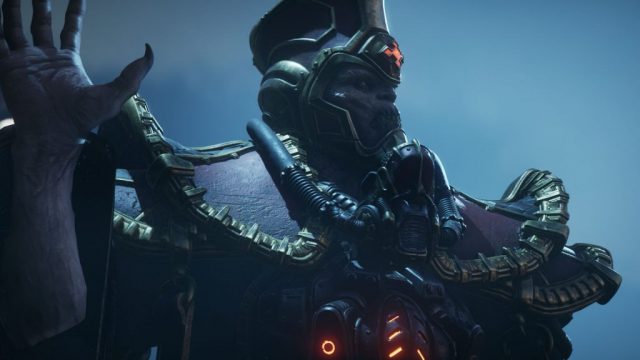
Better still, while Gears Tactics is best experienced on a beefy, high-end gaming PC, where you can really flex the game’s plentiful technical options to sublime effect, you don’t necessarily need a high-powered rig to run it, so long as you satisfy the base requirement of having DirectX 12-ready Windows 10 as your OS. The game’s technical potential is just as amazingly customizable as its bevy of potential units for you to fill out your squad with. It’s also appreciated that, like Gears 5 before it, Gears Tactics has been made available on Steam, as well as the Windows 10 Store. Bear in mind however that Gears Tactics will likely support Play Anywhere when it eventually comes to Xbox One, so buying the game on Steam is best done by people who don’t see any need to play the upcoming Xbox One version, or don’t even own an Xbox One in the first place. Fortunately, the Steam version of Gears Tactics does at least share achievements with your Xbox Live profile though, allowing any achievements earned on PC to carry over to your potential time with Gears Tactics’ Xbox One port and vice-versa, regardless of whether you bought the PC version on Steam or the Windows 10 Store.
Even with all those achievements to earn however, Gears Tactics’ post-game content is a little wanting, especially when some players will inevitably be displeased by the disappointingly inconsequential story, along with the complete lack of multiplayer. Still, Gears Tactics’ lengthy campaign, robust gameplay options and outstanding production values nonetheless make it one of the most impressive and satisfying Windows 10-oriented games that Xbox Game Studios has delivered to date! Gears Tactics will likely be just as fun and rewarding to play on Xbox One, when it eventually arrives there, but it’s nonetheless very apparent that this game is primarily meant to be enjoyed on a gaming PC, where it proves that Windows 10 can still be home to its own selection of top-quality first-party games, even as more and more audience attention is beginning to turn towards the Xbox Series X.
This review is based on the PC version of, “Gears Tactics”, played from a Steam Key provided by publisher, Xbox Game Studios.

